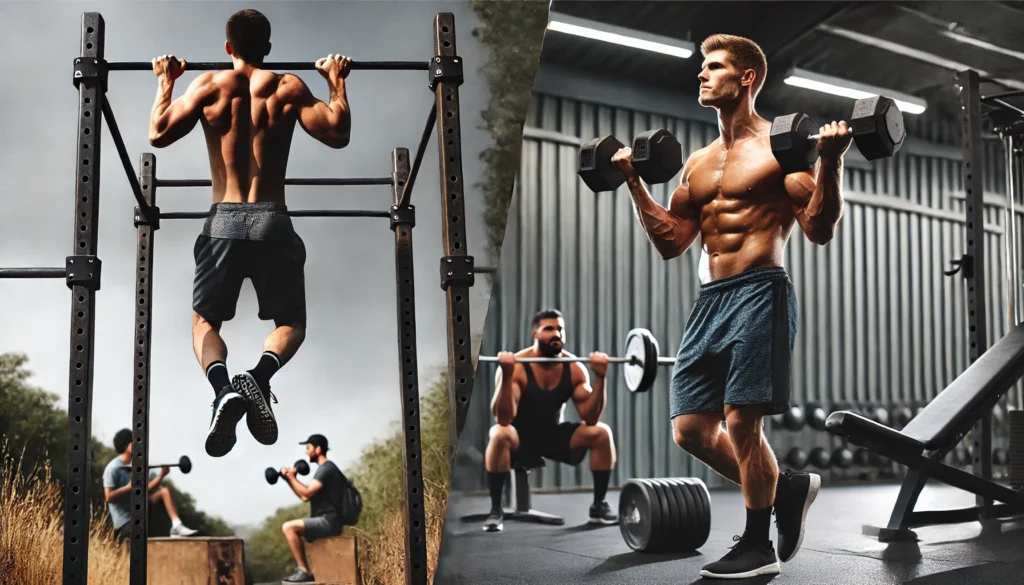Understanding the Fundamentals of Bodyweight and Weight Training
In the ever-evolving world of fitness, the debate surrounding body weight exercises vs weight training remains a compelling discussion. As fitness enthusiasts and professionals seek the most effective methods for building strength, endurance, and overall performance, understanding the fundamental differences between these two approaches is crucial. Body weight training involves using one’s own mass as resistance, incorporating exercises such as push-ups, pull-ups, squats, and planks to enhance muscular strength and endurance. On the other hand, weight training involves external resistance, including dumbbells, barbells, and machines, to stimulate muscle hypertrophy and strength gains. Each modality offers unique benefits, and determining which delivers the best fitness results depends on various factors, including individual goals, experience levels, and physical conditions.
You may also like: The Ultimate Bodyweight Workout Routine for Full-Body Strength and Performance
Historically, bodyweight exercises have been the cornerstone of physical training, dating back to ancient civilizations where warriors relied on calisthenics to develop combat readiness. Conversely, weight training gained prominence in the modern era, especially with the rise of bodybuilding and strength sports. Despite their distinct origins, both training modalities share a common goal: improving muscular function, endurance, and overall health. The question remains—how do these approaches compare when it comes to achieving peak fitness?
Strength and Muscle Growth: How Do They Compare?
One of the primary considerations when evaluating body weight exercises vs weight training is the ability to stimulate muscle hypertrophy and strength development. Weight training is often associated with greater muscle mass gains due to the ability to progressively overload muscles. By increasing resistance incrementally, weight training allows for systematic muscle fiber recruitment, leading to hypertrophy. In contrast, bodyweight exercises rely on manipulating leverage, repetition volume, and time under tension to achieve similar effects.
A significant advantage of weight training is its capacity for precise load adjustments. For example, an individual performing a bench press can gradually increase the weight, ensuring continuous muscle adaptation. This level of specificity is harder to achieve with body weight training, which often requires advanced progressions such as one-arm push-ups or weighted calisthenics to match the resistance levels of traditional lifting. While body weight exercises can still promote muscle growth, they generally require more creativity and technique modification to replicate the progressive overload achieved with free weights.
Functional Strength and Mobility: Which Approach Excels?
Functional strength—the ability to perform everyday tasks efficiently—plays a crucial role in overall fitness. In this regard, body weight training has a distinct advantage due to its emphasis on movement patterns that closely mimic real-life activities. Exercises like push-ups, lunges, and pull-ups engage multiple muscle groups simultaneously, enhancing coordination and balance. Additionally, body weight training often promotes joint health by incorporating dynamic movements that improve mobility and flexibility.
Weight training, while exceptional for developing raw strength, can sometimes lead to muscle imbalances if exercises are not executed with proper technique and variety. Certain weightlifting movements, such as deadlifts and squats, undoubtedly build functional strength, but without adequate mobility work, they may lead to stiffness. However, a well-structured weight training program that includes mobility drills and compound movements can be equally effective in fostering functional fitness.

Fat Loss and Metabolic Impact: Which Is More Effective?
When it comes to fat loss and metabolic conditioning, both weight training and body weight exercises offer compelling benefits. High-intensity bodyweight training, particularly in the form of circuit workouts or calisthenics, can elevate heart rate and burn calories efficiently. Exercises like burpees, mountain climbers, and jump squats incorporate both strength and cardiovascular elements, making them excellent choices for metabolic conditioning.
Weight training, particularly when incorporating compound lifts such as squats, deadlifts, and presses, also has a profound impact on fat loss. Resistance training stimulates excess post-exercise oxygen consumption (EPOC), leading to increased calorie burn even after the workout has concluded. Additionally, the muscle mass gained through weight training enhances basal metabolic rate (BMR), leading to long-term fat-burning potential. The optimal approach to fat loss may involve a hybrid model that integrates both training styles, maximizing calorie expenditure and metabolic efficiency.
Accessibility, Convenience, and Practicality
One of the most significant advantages of body weight training is its accessibility. With no need for specialized equipment, body weight exercises can be performed virtually anywhere, making them an ideal choice for individuals with limited access to a gym. This convenience is particularly beneficial for those who prefer home workouts or travel frequently. Furthermore, body weight training requires minimal financial investment, eliminating the need for costly gym memberships or home exercise equipment.
Conversely, weight training typically necessitates access to equipment, whether at a commercial gym or a well-equipped home gym. While adjustable dumbbells and resistance bands can provide some flexibility, a comprehensive weight training program often relies on barbells, machines, and specialized equipment. However, the investment in a structured weight training program can yield significant strength and hypertrophy benefits, making it a worthwhile consideration for individuals aiming to build substantial muscle mass.
Injury Risk and Longevity
Injury prevention and long-term sustainability are critical factors in selecting an appropriate training modality. Body weight training generally places less stress on the joints compared to heavy weightlifting, making it a suitable option for individuals recovering from injuries or those with joint sensitivities. The dynamic nature of body weight exercises often encourages better movement mechanics and flexibility, reducing the risk of overuse injuries.
Weight training, when performed with proper technique, offers immense benefits in bone density, joint health, and muscle strength. However, improper lifting form, excessive loads, and inadequate recovery can increase the risk of injuries, such as muscle strains or joint degeneration. A well-balanced approach that includes mobility work, proper warm-ups, and recovery strategies can mitigate these risks, ensuring long-term training success.

Frequently Asked Questions (FAQ): Body Weight Exercises vs. Weight Training
1. Is one method better than the other for overall fitness—bodyweight training or weightlifting?
The effectiveness of weight training and bodyweight training depends largely on the individual’s fitness goals, training style, and physical condition. If overall functional fitness is a priority, body weight exercises vs weight training can be an ongoing debate, as bodyweight exercises promote flexibility, mobility, and endurance. However, weight training allows for precise control over resistance and progressive overload, making it more effective for targeted muscle growth and absolute strength gains. For those aiming to develop athletic power or competitive lifting abilities, weight training is essential, while bodyweight workouts are often superior for calisthenics athletes, gymnasts, and endurance-focused individuals. The best approach for overall fitness is often a combination of both, utilizing body weight or weight lifting methods to create a well-rounded routine that enhances multiple aspects of physical health.
2. How does bodyweight training compare to weightlifting in terms of injury prevention?
When analyzing bodyweight vs weights in terms of injury risk, bodyweight exercises generally pose a lower risk because they rely on natural movement patterns and reduce excessive strain on joints. Many injuries associated with weight training result from improper form, excessive loading, or muscular imbalances caused by an overemphasis on specific muscle groups. However, body weight exercises vs weight training both have inherent risks, especially if movements are performed incorrectly or without proper progression. Bodyweight workouts may lead to repetitive strain injuries if overused, while weightlifting can result in acute injuries due to improper mechanics or excessive load. Regardless of the chosen method, proper warm-ups, recovery strategies, and balanced programming are crucial for minimizing injury risk.
3. Can bodyweight training build muscle as effectively as weight training?
While body weight training vs weight lifting both offer muscle-building benefits, traditional weightlifting has an edge when it comes to hypertrophy. Weights vs bodyweight exercises differ primarily in their ability to provide progressive overload—an essential component of muscle growth. Weight training allows for consistent increases in resistance, making it easier to target specific muscle groups and induce hypertrophy. However, advanced bodyweight training techniques, such as one-arm push-ups, pistol squats, and weighted calisthenics, can still produce significant muscle gains. The key is to continuously challenge muscles through increased resistance, time under tension, and varied movement patterns.
4. Which method is better for fat loss—bodyweight exercises or weight training?
Both body weight exercises vs weight training can be effective for fat loss, but their mechanisms differ slightly. Bodyweight workouts, particularly those that incorporate high-intensity interval training (HIIT), elevate heart rate and enhance calorie burn through cardiovascular engagement. Weight training, on the other hand, builds lean muscle mass, which increases metabolic rate and promotes long-term fat-burning effects. The best fat loss results often come from a combination of both methods, using body weight or weight lifting in strategic ways to maximize calorie expenditure while preserving muscle mass.
5. How does bodyweight training affect flexibility and mobility compared to weightlifting?
One of the biggest advantages of body weight exercises vs weight training is their inherent focus on natural movement patterns that improve flexibility and mobility. Many bodyweight exercises, such as lunges, deep squats, and yoga-inspired movements, promote joint range of motion and functional strength. In contrast, traditional weightlifting can sometimes lead to stiffness if mobility work is neglected. However, incorporating mobility-focused weightlifting exercises, such as kettlebell training and dynamic stretching, can mitigate these effects. Whether using bodyweight vs weights, maintaining flexibility through dynamic stretching, mobility drills, and proper warm-ups is essential for optimal performance and injury prevention.
6. What are the psychological benefits of bodyweight training vs. weightlifting?
Beyond physical advantages, weight training and bodyweight training each offer unique psychological benefits. Bodyweight training often promotes a sense of autonomy and freedom since it can be done anywhere, making it an accessible and low-barrier form of exercise. Many individuals find bodyweight workouts meditative and empowering due to their emphasis on body control and mastery. Weight training, on the other hand, is highly structured and goal-oriented, which can be psychologically rewarding for those who enjoy tracking progress and achieving measurable strength milestones. Whether an individual thrives on structured progression or prefers adaptable, movement-based training, choosing between weights vs bodyweight exercises should consider mental well-being as much as physical results.
7. Which training method is more suitable for athletes?
Athletes often require a blend of strength, endurance, power, and agility, making it difficult to choose solely between body weight training vs weight lifting. In sports where explosive power is essential, such as football or Olympic weightlifting, traditional weight training is invaluable for building maximal strength. However, sports that emphasize agility, endurance, and body control—such as gymnastics, martial arts, and rock climbing—benefit greatly from bodyweight training. Many professional athletes integrate both training styles to develop a well-rounded skill set, demonstrating that bodyweight vs weights is not an either-or decision but a matter of applying the right tools for specific athletic needs.
8. Can older adults benefit more from bodyweight training or weightlifting?
For older adults, body weight or weight lifting exercises must be carefully selected to accommodate joint health, bone density, and overall mobility. Bodyweight training is often recommended as a safe and effective option for maintaining muscle mass, flexibility, and functional strength without placing excessive strain on the joints. However, weight training is equally important for older individuals, as resistance exercises help combat age-related muscle loss (sarcopenia) and maintain bone density. A combination of both—using low-impact body weight exercises and controlled resistance training—provides the best approach to longevity and sustained independence.
9. Are there any emerging trends in fitness that combine bodyweight and weightlifting techniques?
Modern fitness trends increasingly emphasize hybrid training programs that integrate both weight training and bodyweight training. Methods such as functional fitness, CrossFit, and movement-based strength training blend traditional resistance training with bodyweight movements to create well-rounded workouts. Additionally, suspension training, kettlebell exercises, and weighted calisthenics are growing in popularity as ways to merge the benefits of both training styles. As fitness evolves, the debate of body weight exercises vs weight training becomes less about choosing one over the other and more about finding optimal synergy between the two.
10. How should beginners decide between bodyweight and weight training?
For beginners, choosing between bodyweight vs weights depends on personal goals, current fitness level, and available resources. Body weight exercises offer a great starting point for building foundational strength, learning proper movement patterns, and minimizing injury risk. Weight training, while requiring more equipment and supervision, is ideal for those looking to build muscle mass and strength systematically. Beginners should focus on mastering basic bodyweight exercises before gradually incorporating weights, ensuring proper form and balanced progression. Ultimately, developing a personalized plan that includes elements of both training methods will yield the best long-term fitness results.

Conclusion: Finding the Optimal Training Approach
Ultimately, the choice between weight training and bodyweight training depends on individual goals, preferences, and lifestyle factors. Those seeking maximum muscle hypertrophy and strength may benefit from a structured weightlifting regimen, while individuals prioritizing functional fitness, mobility, and convenience may find bodyweight exercises more suitable. In many cases, a hybrid approach that integrates both modalities can provide the best of both worlds, optimizing strength, endurance, and overall fitness.
By understanding the unique benefits and limitations of each training method, individuals can tailor their workout routines to align with their specific objectives. Whether leveraging the convenience of body weight exercises or the progressive overload capabilities of weight training, the key lies in consistency, proper programming, and a commitment to long-term fitness.
strength training benefits, functional fitness exercises, progressive overload training, resistance training vs bodyweight, calisthenics vs weightlifting, home workout routines, fitness training methods, muscle hypertrophy strategies, exercise science insights, weightlifting vs calisthenics, mobility and strength, injury prevention in strength training, cardiovascular benefits of exercise, gym workouts vs home workouts, fitness equipment vs bodyweight, building muscle without weights, high-intensity interval training (HIIT), strength and endurance training, fitness performance enhancement, optimal workout strategies.
Further Reading:
Bodyweight vs Weights: Which Is Better for You?
Bodyweight vs Weight Training: Which One Makes Sense for You?
Body-weight exercises vs weight lifting: Which is better for you? Let’s find out
Important Note: The content provided by HealthXWire is for informational purposes only and should not be construed as medical advice, diagnosis, or treatment. While we strive for accuracy, the information presented on this site may not reflect the most current research or medical guidelines. Always seek the advice of your physician or other qualified health provider with any questions you may have regarding a medical condition. HealthXWire does not endorse, recommend, or guarantee the efficacy of any products, services, or treatments mentioned on this site. Users should not disregard professional medical advice or delay seeking it because of something they have read on HealthXWire. HealthXWire is not liable for any damages, loss, or injury arising from reliance on the information provided herein.



